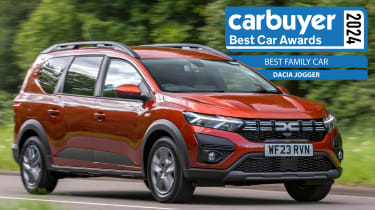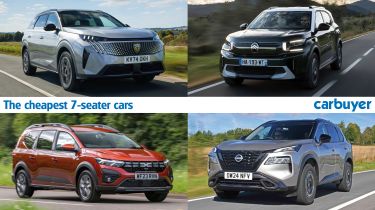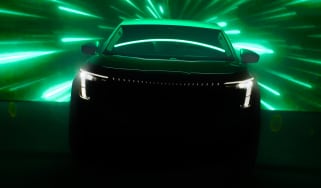Dacia Jogger review – the best-value seven-seater


Finding an affordable new car with seven seats is easier said than done. More seats leads to a bigger car, which usually results in a heftier price tag. While a seven-seater will likely never be as cheap as a typical hatchback, we have rounded up the most affordable options currently on sale.
It wasn’t so long ago that this list would have been composed entirely of MPVs, otherwise known as people carriers. That is no longer the case, as car makers have dropped many of their once-popular models, such as the Renault Espace and Ford Galaxy, in favour of trendy SUVs. To fill the practical and spacious void left behind, some manufacturers now offer SUVs with seven seats instead, catering to those who want a large people-mover with off-roader styling.
 Top 10 cars with the biggest boots
Top 10 cars with the biggest boots
We’ve often found that seven-seater SUVs aren’t as practical as traditional MPVs – their raised ride-height tends to eat into interior space. However, if you only plan to use the third row of seats for kids then you’re unlikely to be short on room. Plus, many buyers prefer the styling of chunky SUVs over MPVs, which tend to look a bit van-like.
Even so, a handful of manufacturers continue to offer traditional MPVs, the vast majority of which are based on vans. They may not offer the fashionable looks of their SUV cousins, but they prioritise space and versatility over style, something that will appeal to many families. Van-based MPVs are some of the roomiest cars on sale and, fortunately, there are several affordable models that appear on this list.
Many manufacturers have dropped diesel engines from their van-based MPVs, instead opting for petrol or fully electric powertrains. The latter can significantly inflate the purchase price but don’t discount them straight away. If you’re able to recharge your EV at home, they offer the potential for far lower running costs than petrol and diesel models. Most can travel upwards of 200 miles on a charge as well, which should be enough if you mainly stick to urban driving.
While you’re here and interested in practical cars, we have other guides to the best cars with seven-seats and the best eight-seater cars. Check them out once you’ve finished reading about the cheapest seven-seater cars currently on sale.
The Dacia Jogger elbowed its way into the seven-seat market several years ago, and proved a great success with its vast interior space and exceptional value. It's neither an MPV, SUV or estate car, instead combining attributes of all three, and it comes with seven seats as standard along with plenty of standard equipment. The removable pair of rearmost seats don’t weigh very much, so can be installed or taken out with ease, and you’re left with a huge 699-litre boot if you leave them at home. Unusually, the third row of seats is spacious enough for adults.
Dacia is well-known for its sharp focus on value, but it’s hard to believe that the Jogger starts at just over £18,000. For context, that’s half of what you’ll pay for some of the cars on this list, but the base Essential model still features LED headlights, rear parking sensors and air conditioning. Even the range-topping Extreme model costs less than what you’d pay for the cheapest Volkswagen Polo. If you’re looking for something with seven seats, nothing touches the Dacia Jogger in terms of value.
| Pros | Cons |
|
|
Find new and used deals for the Dacia Jogger on our sister site Auto Express
The Citroen C3 supermini has already cemented itself as a great-value supermini, but there’s now a new ‘Aircross’ SUV version with more space and up to seven seats. Even with the chunkier bodywork, it hardly costs any more than the supermini, starting at just over £20,000. There are five seats fitted as standard, but adding the extra third row only costs £765, so it’s still remarkably affordable.
Despite the low price tag, the C3 Aircross is well equipped, coming with a 10.25-inch infotainment screen, automatic air-conditioning and a digital dashboard. The ‘advanced comfort’ seats are a real highlight, featuring memory foam to improve comfort, while the trick suspension uses ‘hydraulic cushions’ to soak up bumps. The result is excellent ride quality, which will be a big tick for seven-seater buyers.
The low entry price gets you a C3 Aircross with the 1.2-litre petrol engine and manual gearbox. It’s just about powerful enough, and returns respectable economy figures. Above this sits an automatic mild hybrid for better fuel efficiency, or there’s even a fully-electric e-C3 Aircross, but this isn’t available with seven seats.
| Pros | Cons |
|
|
Find new and used deals for the Citroen C3 Aircross on our sister site Auto Express
There’s not much to say about the Vauxhall Frontera that we haven’t already said about the Citroen C3 Aircross – they’re the same cars underneath, after all. The Vauxhall will cost you a little more, especially if you opt for the seven-seat package. This is only available with the pricier GS trim level, meaning a seven-seat Frontera will set you back around £26,000.
Still, you get plenty of kit for your money. There’s a pair of 10-inch interior displays, front and rear parking sensors, a reversing camera and more, all squeezed into a compact SUV body. It’s quite a narrow car, so there’s not a lot of width across the second row of seats, but headroom was impressive. Given the size of the Frontera, the third row of seats will probably be best suited to children but this is no different to the C3 Aircross.
You have a choice of two powertrains: an automatic petrol mild hybrid or a fully-electric model. Unusually, both are priced identically, but due to the placement of the batteries, the EV is a five-seater only.
| Pros | Cons |
|
|
Find new and used Vauxhall deals on our sister site Auto Express
The Volkswagen Caddy may be based on a commercial van, but from behind the wheel, it feels far closer to the Volkswagen Golf. Much of the interior is shared between the two cars, meaning you get hard-wearing materials and a good level of equipment. It even drives like a Golf too, with a generally comfortable ride and a strong choice of petrol and diesel engines.
Where the Caddy differs is interior space – it’s huge, with masses of headroom and a giant boot. It’s offered in two lengths and both can be fitted with seven seats – the longer Caddy Maxi just has slightly more room. There are two trim levels and it's tempting to upgrade to the higher-spec Life version, but even the unnamed base model comes with Bluetooth, DAB radio, cruise control and heated mirrors.
At just under £30,000, it’s a hefty step up from the ultra-affordable Dacia Jogger, but offers more interior space, a better driving experience, and useful sliding doors. Compared to the other cars on this list, the Volkswagen Caddy still offers good value for money.
| Pros | Cons |
|
|
Find new and used deals for the Volkswagen Caddy on our sister site Auto Express
The Citroen Berlingo is another van-based MPV, but unlike the Volkswagen Caddy, it’s available as a pure EV – the e-Berlingo. Following an overhaul in 2024, it’s only this model that’s available with seven-seats, but it’s still an affordable option, albeit not quite as affordable as the five-seater petrol version.
The e-Berlingo’s 213-mile range may not appeal to all drivers, but it should suit families who largely stick to shorter journeys. There’s 100kW rapid charging compatibility, and its 134bhp is enough to provide nippy acceleration around town. It has sliding doors for easy access, and the vast headroom and boot space typical of a van-based MPV. The cockpit is fairly pleasant, too, with a digital driver’s display and standard Apple CarPlay and Android Auto.
It’s also worth noting that the Citroen Berlingo is sold under a different name by Peugeot Vauxhall and Toyota, as the Peugeot Rifter, Vauxhall Combo Life and Toyota City Verso. All offer the same EV option, but the Citroen is the cheapest of the lot, so we picked it for this list.
| Pros | Cons |
|
|
Find new and used deals for the Citroen e-Berlingo on our sister site Auto Express
The latest Ford Tourneo Connect is essentially the same car as the Volkswagen Caddy, although opting for the blue oval badge on the nose nudges the price over £30,000. Like the Volkswagen, you get a vast interior, sliding doors and the same choice of petrol or diesel engines.
For maximum interior and boot space, you can upgrade to the longer Grand Tourneo bodystyle, but the regular Tourneo will be big enough for most families and can still seat seven people. Although the Tourneo Connect is marginally more expensive than the Volkswagen Caddy, it offers more in the way of standard interior kit. Even the base Titanium trim comes with a 10-inch infotainment display with Apple CarPlay and Android Auto, as well as heated seats – both optional extras on the Volkswagen.
| Pros | Cons |
|
|
Find new and used deals for the Ford Tourneo Connect on our sister site Auto Express
The entry-level, seven-seater Nissan X-Trail starts from roughly £35,000, offering enough space for five adults, plus two children in the third row. It’s a good all-rounder, with comfortable suspension, optional four-wheel drive and a practical interior.
While more expensive versions of the X-Trail come equipped with a 12.3-inch infotainment touchscreen, head-up display and power tailgate, the entry-level Acenta Premium model misses out on a few key features – at least you get an 8-inch infotainment system these days, unlike earlier versions of the X-Trail which made do with a basic radio. We’d still recommend spending a bit extra to upgrade to a mid-spec model. Adding the extra pair of seats costs £1,000, and they’re realistically only for kids. At least the middle row can slide forward to create a bit more space.
The basic engine is a 1.5-litre three-cylinder unit with mild hybrid assistance. It’s fairly economical, returning up to 40mpg, but the CVT automatic gearbox can make it feel rather sluggish at times. Buyers can upgrade to Nissan’s complex e-Power hybrid engine for more power, but it comes at a £2,500 premium and returns a slightly disappointing 50mpg.
| Pros | Cons |
|
|
Find new and used deals for the Nissan X-Trail on our sister site Auto Express
Technically, the Citroen e-SpaceTourer isn’t a seven-seater as it can comfortably seat up to nine people. It is unmistakably a van-based MPV, with giant sliding doors and a cavernous interior. Its commercial origins pay dividends in terms of practicality, but its large size and delivery-van looks will only appeal to a niche audience.
That being said, you’ll struggle to find an MPV that can seat seven people with such space. The suspension is comfortable and it feels impressively car-like to drive. Citroen dropped the petrol and diesel versions of the SpaceTourer in 2022, leaving the electric e-SpaceTourer as the sole option. The base model gets a 50kWh battery with just 136 miles of range, so we’d avoid this model. The 75kWh model is over £5,000 more expensive, but its range shoots up to a far more usable 215 miles.
At just over £38,000, it provides the most space for your money, but we think the majority of families will be better off with something smaller. Like its van-based Berlingo sibling, the e-SpaceTourer is also sold by other manufacturers; badged Peugeot Traveller and Vauxhall Vivaro Life.
| Pros | Cons |
|
|
Find new and used deals for the Citroen e-SpaceTourer on our sister site Auto Express
The Peugeot 3008 is a stylish and capable mid-size SUV, and the bigger 5008 goes about things in much the same way – just with an extra pair of seats in the back. Besides a longer rear end, the styling is pretty similar, and so is the interior. You get Peugeot’s latest digital i-Cockpit, plus smartphone connectivity and a reassuring number of safety systems.
The old 5008 didn’t offer much space in the third row of seats, but Peugeot has made it a bit roomier for the new version. Slide the middle row forward to create a bit more space, and adults can squeeze into the very back, as long as they’re not particularly tall. Getting into the rearmost seats is easy, too, thanks to the sliding middle row.
It’s economical considering its bulk, and Peugeot has focused on making it comfortable on long drives. Although, at over £38,000, we think the other cars on this list offer better value for money if seven seats are your main priority. There’s also a much pricier electric E-5008 which still gets seven seats.
| Pros | Cons |
|
|
Find new and used deals for the Peugeot 5008 on our sister site Auto Express
The Skoda Kodiaq has long been one of our favourite large family cars at Carbuyer, with the latest model picking up the annual award for the category in 2025. While Skoda has often sat as the budget-focused brand in the Volkswagen Group portfolio, its latest models have a genuine premium edge to them, and the Kodiaq is no different. It’s sturdily built, cleverly designed, and features lots of standard equipment.
The entry-level Kodiaq only has five seats, but it doesn’t cost the earth to upgrade to a seven-seater version. Like many other seven-seat SUVs, those rearmost seats are really only for kids or small adults, and they’re not as roomy as some rivals. The rest of the cabin is very spacious, however, with lots of headroom. The old Kodiaq was known for its enormous boot, and the same is true for the latest model – with 910 litres of cargo volume, you’ll struggle to find another SUV with as much space.
There’s one petrol mild-hybrid engine, one diesel engine and one plug-in hybrid engine offered in the Kodiaq. The latter is only available as a five-seater as the battery takes up some of the space in the rear. That’s a bit of a shame as its 71-mile electric range is quite impressive, but at least the petrol and diesel are fairly economical.
| Pros | Cons |
|
|
Find new and used deals for the Skoda Kodiaq on our sister site Auto Express
The table below includes the 10 seven-seater cars on this list with their starting price, price for the seven-seater version, and their Carbuyer score.
| Cheapest seven-seater car ranking | Make and model | Priced from | Seven-seater priced from | Carbuyer rating (out of 5) |
| 1 | Dacia Jogger | £18,000 | £18,000 | 4 |
| 2 | Citroen C3 Aircross | £20,000 | £21,000 | 4.3 |
| 3 | Vauxhall Frontera | £23,000 | £26,000 | 4.1 |
| 4 | Volkswagen Caddy | £28,000 | £29,000 | 4 |
| 5 | Citroen Berlingo | £23,000 | £32,000 | 3.7 |
| 6 | Ford Tourneo Connect | £34,000 | £35,000 | 4 |
| 7 | Nissan X-Trail | £35,000 | £36,000 | 3.9 |
| 8 | Citroen e-SpaceTourer | £38,000 | £38,000 | 3.8 |
| 9 | Peugeot 5008 | £38,000 | £38,000 | 4.1 |
| 10 | Skoda Kodiaq | £38,000 | £39,000 | 4.3 |
Visit our sister site Auto Express to see the latest new and used MPV deals…



